Home » Other Articles » Tuesday Treasures Index » Tuesday Treasures - August 2022 - Tuesday Treasures - August 2022
Tuesday Treasures - August 2022
TUESDAY 30 AUGUST
A Special GWS Anniversary
This Tuesday Treasures Blog is for us, rather special, as it's about the Great Western Society's own achievements that are over and beyond the locomotive and rolling stock collection so splendidly covered in our companion Blog Going Loco.
In the Society’s 21st Anniversary year of 1982, it made another significant contribution to recording and explaining the GWR story to Didcot Railway Centre's visitors, in creating a Museum building dedicated solely to housing and displaying what we then described as the ‘Small Relics’ collection.
The formal opening took place on 29 August, conducted by John Craven, then famed for his very popular role on TV as presenter of the children's programme News Round. Anyone remember that as a child? Now of course he has risen far and away above that through the widely acclaimed BBC Country File.
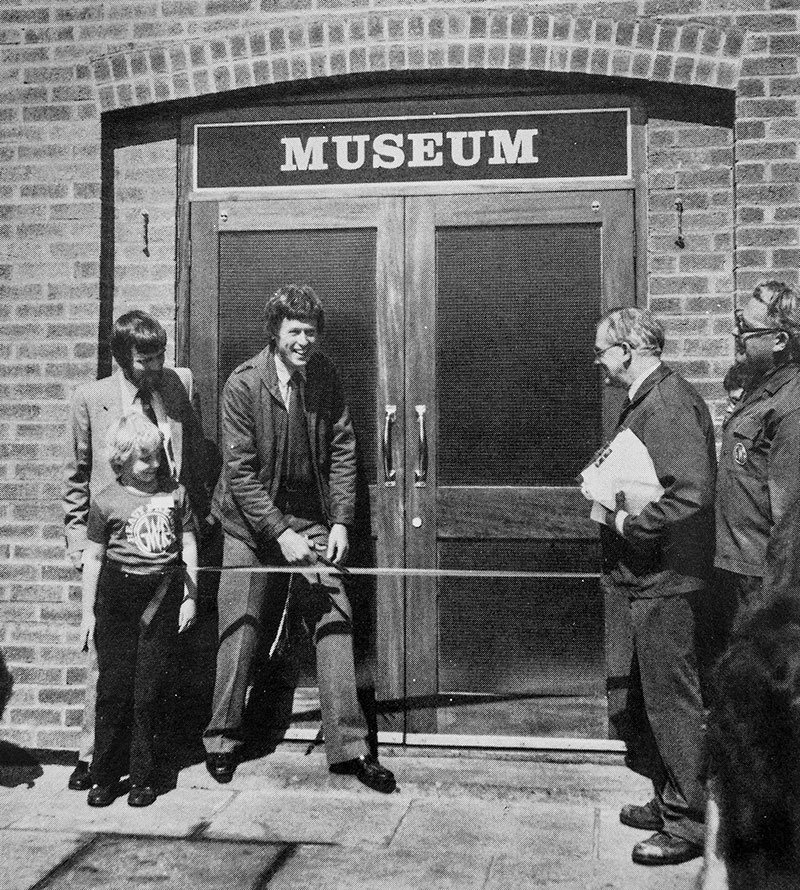
John Craven cutting the ribbon, watched by, left to right, Graham Perry, Elaine Gray, Fred Gray and Geoff Sims
We want to celebrate that opening event, because it's shockingly 40 years ago and that shock results from your Blogger having been one of the volunteer GWS members team who developed that Museum with Fred Gray (now sadly departed) and have been directly involved in its evolution ever since!
When it opened (two views from our GWS member’s journal illustrate that event, of which the second was of a BBCTV crew filming for a future programme) there was a slight air of concern that despite it then housing what the Society had gathered as a collection from its 1961 inception, would it lead to further acquisitions or would Didcot Railway Centre always major upon its locomotives and rolling stock attraction? Well, within months, it was very clear that the Museum of itself, with Fred as its first Curator, was convincing a large number of members and private collectors that it was to be the future permanent home for the “business” side of the GWR, its constituent companies and its BRWR successor. By that we mean its publicity machine, its train service organisation, and most vital of all, all about its staff.
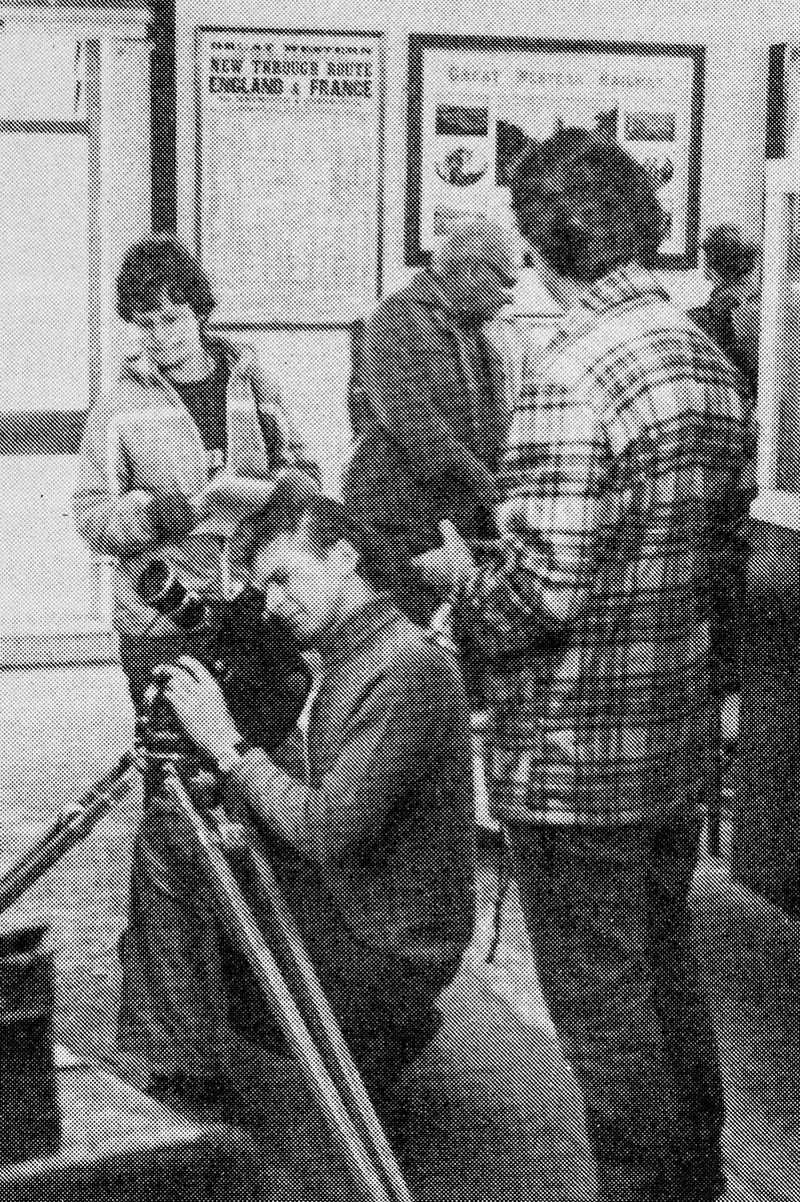
The BBC camera crew filming in the Museum
In fact, so much irreplaceable historic material was now being offered, that quickly the Society decided that a intimately linked but separate Charitable Trust had to be created to own, display, conserve and administer both the existing collection and all future donations and acquisitions. That was the Great Western Trust, created in 1984, and along with Fred Gray as its first Chairman, your blogger became its first administrator, and has remained an active Trustee ever since! This explains his ‘shock’ at reaching a 40th anniversary, being over half of his life!!
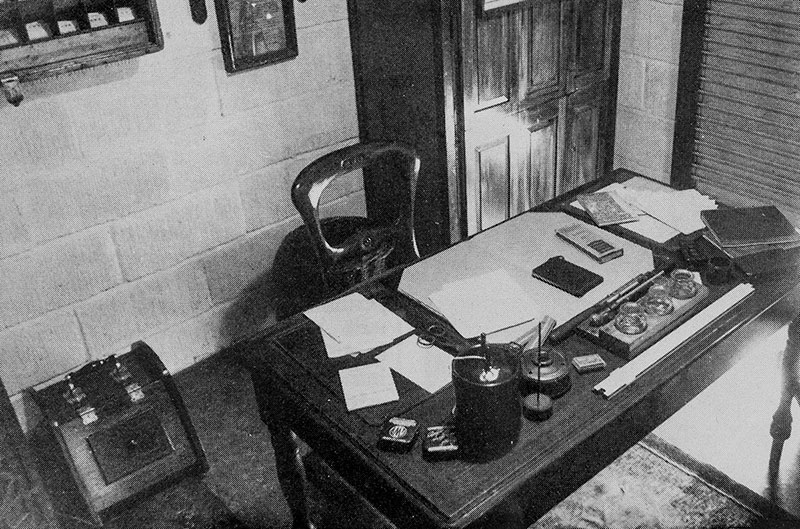
The office scene was a feature at the opening of the Museum
Suffice to say, that the Trust Collection, now more appropriately housed in our renamed Great Western Trust Museum & Archive Building is responsible for a widely acclaimed and unique archive of primary source GWR and BRWR items, both in depth, quality and period covered. A proud distinction being that at its heart, the core collection is located in our secure and archive standard environmentally controlled facility, a unique provision for a volunteer led charitable railway heritage museum.
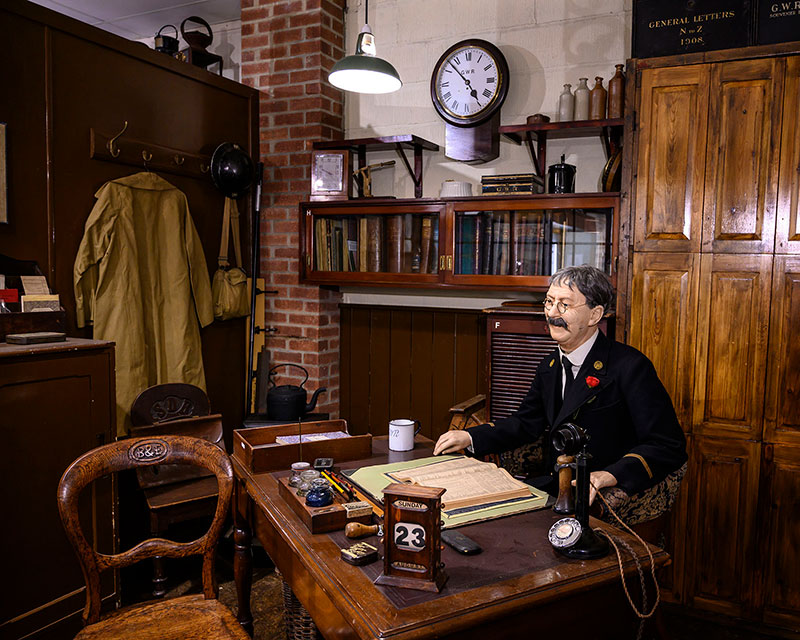
The office scene has acquired many more artefacts over the years, plus a new permanent member of staff
All our achievements owe an immense debt of gratitude to the bold action by the Society in founding our Museum, collecting artefacts and then the countless hours of subsequent volunteer effort to bring it to its present status. The Trustees believe that its presence gives the vital wider view of the GWR’s achievements to complement the locos and rolling stock at Didcot. An exciting future awaits us as we currently plan to extend our display options and with that, the kinds of GWR items we have and want to better display.
Future blogs will cover that progressive story by which we aim to provide even greater reasons for more visitors to Didcot to admire and understand the vast scale of the GWR transport service.
40 years on, we are still looking forward!
TUESDAY 23 AUGUST
TSS St Helier
This week we dive into the Trust’s photographic archive and surface with a nautical theme.
The GWR steamer TSS St Helier was built in by John Brown and Co on the River Clyde as one of a pair of ships, the other being TSS St Julien. As built she carried 1,004 passengers with cargo holds fore and aft. She was oil-fired and equipped with two sets of Parsons compound turbines giving her a cruising speed of 18 knots. She was delivered in June 1925 for use on the Weymouth – Channel Islands service and on 22 August 1925, she docked at Weymouth after crossing from Guernsey. The crew had reported some difficulty on the voyage and a diver was sent down to inspect the ship. He found that a steel hawser had caught up in and wound round the ship’s propeller shaft.
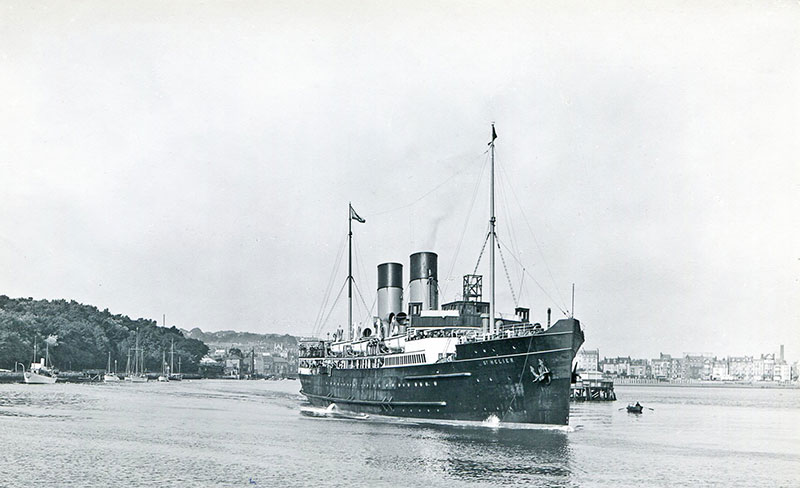
In 1928 the aft funnel which was a dummy, was removed and minor alterations made to the accommodation.
St Helier continued on Channel Islands mail services until the outbreak of war in September 1939 when she was transferred to Fishguard, sailing between there and Rosslare. In November of that year she was requisitioned by the government and spent the next six months on troop transport between Southampton and Cherbourg.
In May and June 1940, during the Dunkirk evacuations St Helier made a remarkable eight Channel crossings and carried to safety 1,500 refugees and over 10,000 allied troops, an outstanding achievement for which Captain Reginald Pitman and the first and second officers received the Distinguished Service Cross and the quartermaster was awarded the Distinguished Service Medal. After Dunkirk, she saw service transporting prisoners of war between Gourock on the Clyde and internment camps on the Isle of Man.
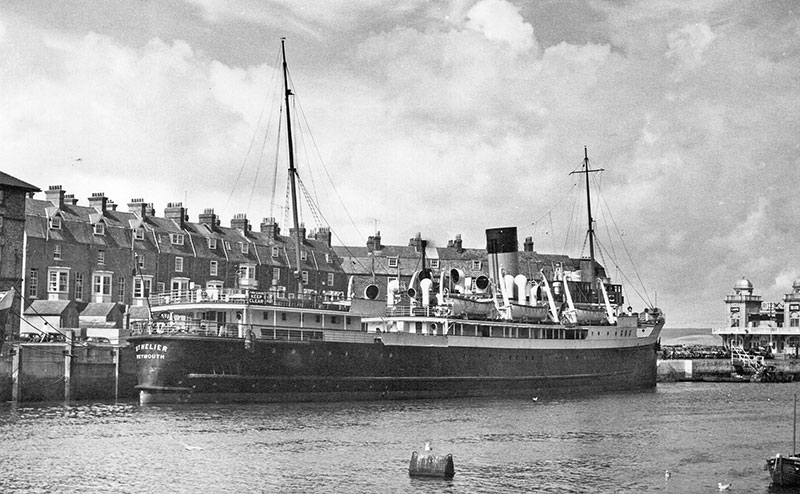
She was then taken over by the Navy and became HMS St Helier spending the rest of the war in naval service being converted to an assault ship prior to the D-Day landings in 1944.
After the war she resumed her Channel Islands mail service until September 1960 when she was laid up and in December, towed away for scrapping in Antwerp, a sad end to an illustrious career.
The first photograph shows St Helier as built leaving Weymouth when nearly new and the second berthed at Weymouth in June 1954 (P J Kelley).
Information from The Great Western at Weymouth by John Lucking, published by David & Charles 1971. ISBN 0 7153 6176 7
TUESDAY 16 AUGUST
Accidents Did Happen – No. 2
Our Blog readers, my recall two previous articles on this subject.
Today’s Blog reflects rather a mystery to us. We illustrate from our Great Western Trust collection this official printed Notice to Enginemen and all concerned, sent from on high in the GWR hierarchy, from one C T Cox then Divisional Superintendent of the London Division.
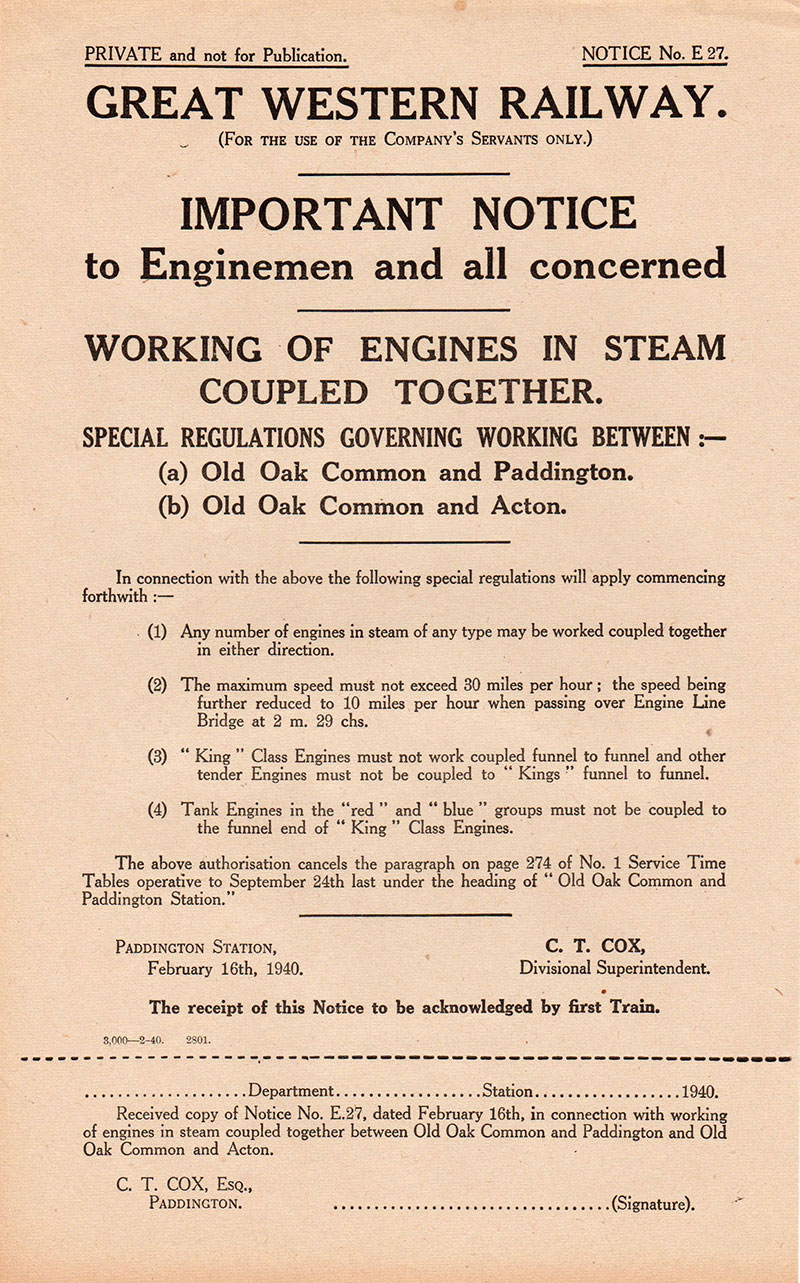
Issued under the title IMPORTANT NOTICE during wartime, on 10 February 1940, it imposes immediate (they used ‘forthwith’) implementation of four specific rules of coupling locomotives when sent from Old Oak Common (OOC) depot to Paddington (station) or Acton (goods yard).
That it was issued at all, and at that particular time, implies at least that an ‘incident’ or more so, had caused it to be created and then imposed with immediate effect. More intriguing are items (3) & (4) by which King class locos were not to be coupled funnel to funnel, or to any other locos including tank engines of a particular axle load (derived from the Red & Blue group branding)
The mystery lies in wondering why any pair of Kings would be sent to Paddington ‘funnel to funnel’ when surely they were to do so only to attach to a prepared train carriage formation.
Yes, the notice adds that it cancels a specific paragraph in the staff only Service Timetable No1 (covering the London Division) of 24 September 1939, but even so, how was such a funnel to funnel coupling ever sanctioned?
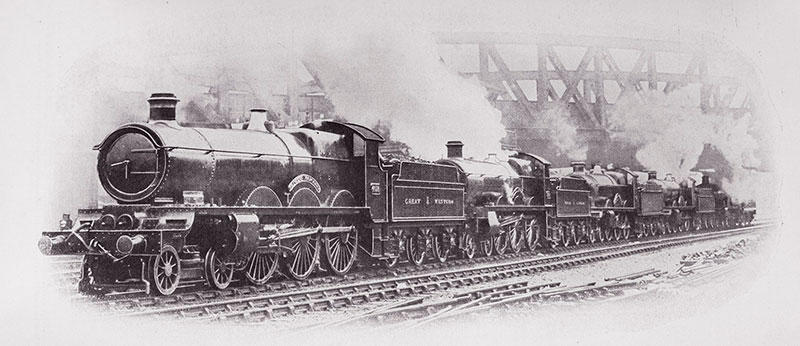
On Saturday 31 July 1926 the Cornish Riviera Limited ran in five portions and the five locomotives ran coupled together from Old Oak Common to Paddington to take over their trains
We can only speculate that the ‘error’ had come to painful light through a derailment, and had it occurred on the OOC to Paddington locomotive line, its operational impact would have been dire at any date, but during wartime absolutely critical. Could it have arisen when OOC turntables were unusable? Will we ever know the true story?
The GWS happily has our very own 6023 King Edward II to illustrate the massive axle load reality of these beasts, and maybe when coupled ‘funnel to funnel’ their combined dynamic load on the track created severe stresses in rail joints or on points (technically called ‘turnouts’). We do not intend to conduct such a demonstration trial!
TUESDAY 9 AUGUST
Eighty seven years ago on 9 August 1935 the first ‘Quick Lunch and Snack Bar’ at any railway station in the country was opened by the GWR on Platform 1 at Paddington Station. The fully-licensed horse-shoe shaped bar had accommodation for twenty seven persons on tall green-topped chromium-plated stools. Under the counter were recesses for hats, gloves, newspapers, ladies’ handbags and other small items. Speedy and skilful service was given by white coated chefs.
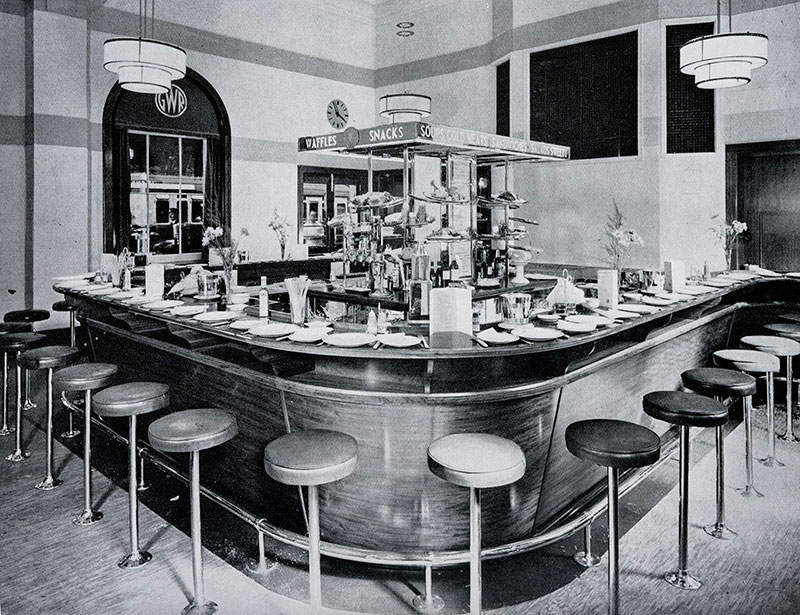
The menu was extensive and varied, there being over a hundred items both hot and cold from which to choose, including a cold buffet, salads, fish (including oysters in season), meats, poultry, waffles, soups and hors d’œuvre plus a wide range of sandwiches made in the presence of the customer. There was a ‘Plymouth Hoe’ meat sandwich and a selection of six meat or fish and salad sandwiches known as ‘Paddington Three Deckers’. Cornish pasties and other regional specialities from locations served by the GWR were offered from time to time.

The service equipment was of the latest type and included a large centre show-case and stand, a modern hot-plate, a combined tea and coffee set, and a waffle-baker and toaster. An automatic electric refrigeration plant was also installed. The bar was open between 8 am and 10 pm on weekdays and from 7 pm to 10 pm on Sundays. All metalwork was either chrome or stainless steel and the walls were painted cream with fawn bands. The counter was made of walnut with a non-stain green top which matched the seat tops.
This information and the accompanying photographs come from the Great Western Railway Magazine which forms part of the Great Western Trust's core collection.
TUESDAY 2 AUGUST
Delivering the Goods – Part 2
In our earlier blogs we covered railway services beyond passenger traffic, such as moving home and transport of bulk liquids by rail. Today, we review a rare example of the staff initiatives created by the nationalised British Railways to promote more traffic.
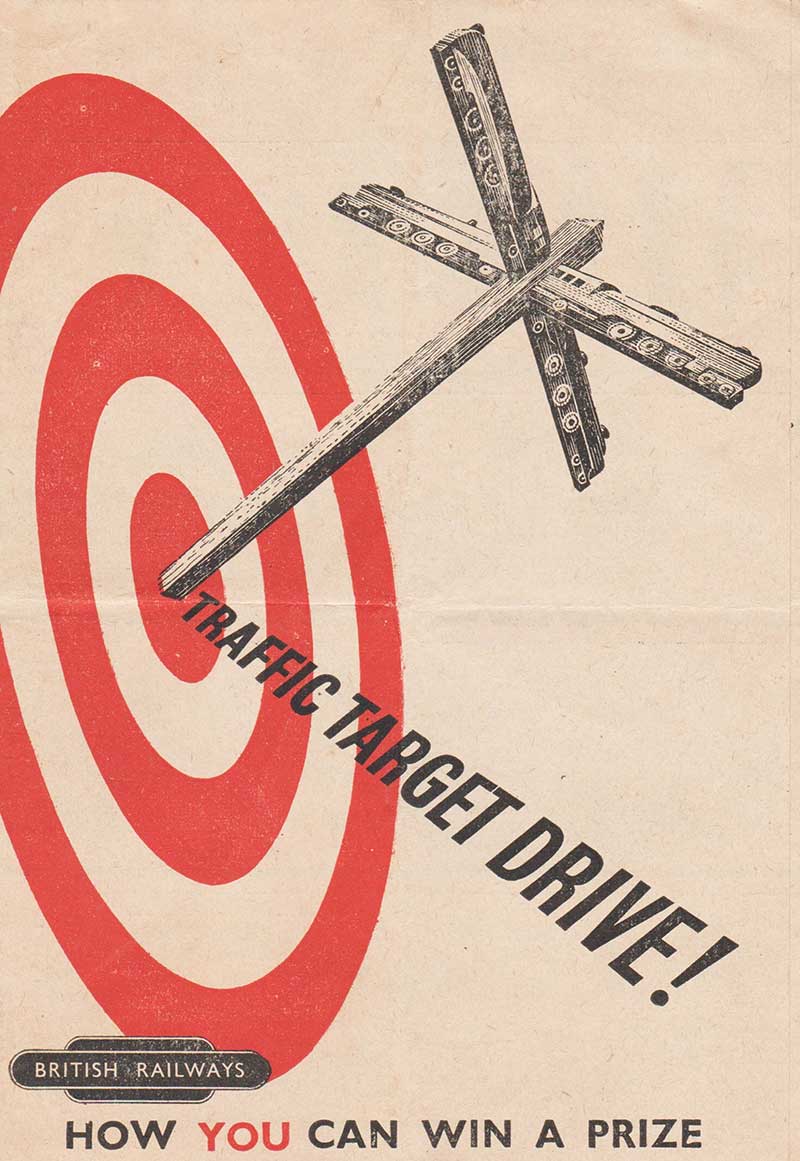
We illustrate from our Great Western Trust collection this rather fragile and rare surviving folded leaflet issued in 1951 to all the Traffic Staff, which department covered Regional, District, Station and individual staff involved in any way with delivering goods and parcels etc etc.
A striking mock arrow and bulls eye target draws attention to ‘How YOU can win a prize’. The 4 locomotive direction post design was also used on other passenger wide publications, but the subject today is the content of this leaflet.
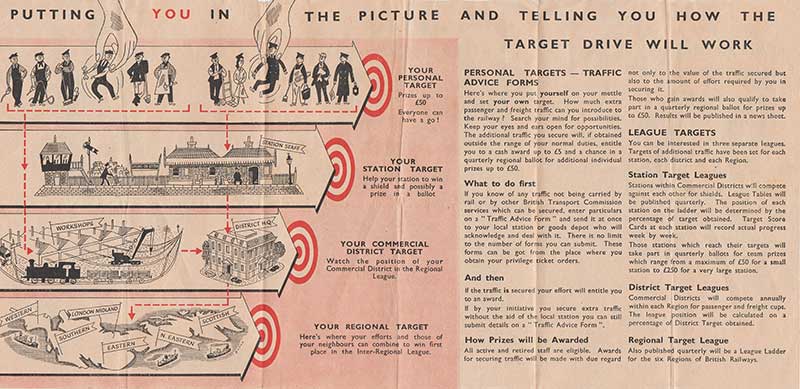
First we notice the key cause of this initiative, namely that in 1951 British Railways needed £10M more in traffic receipts. (Equivalent today of about £220M; Bank of England inflation calculator). So it's a prize scheme offering rewards to individuals of up to £50 (today’s equivalent about £1,100) a station a shield and possibly a prize in a ballot; Commercial District tracked in a league; and Regional in an Inter-Regional League! Wow!
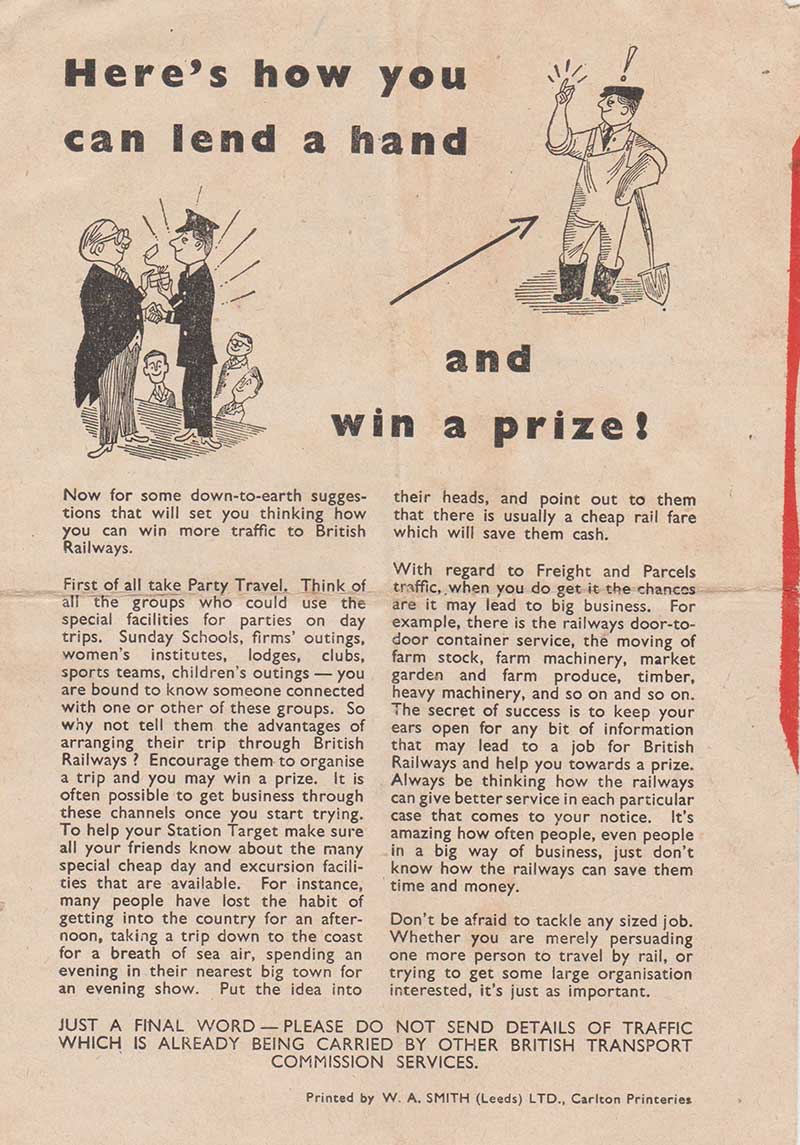
In fact those Regional Target League results were published quarterly in a League Ladder!!
The illustrations expose the very simple scenes created to boost the staff appreciation of the whole endeavour and their vital part within it.
To date, our collection has yet to find any of those awarded ‘Station Shields’ nor papers proving any Western Region staff gaining substantial cash prizes!
Overall however, this simple, remarkable leaflet, demonstrates how important goods traffic was to our railway system, and by that, sadly, today’s shadow service, reflects how dramatically that traffic dwindled in the succeeding years as a proportion of overall receipts.

A typical goods train contemporary with the issue of the Traffic Target Drive leaflet. This southbound goods train on the Gloucester to South Wales main line near Awre was photographed by Ben Brooksbank on 9 August 1951. The Dukedog class 4-4-0 locomotive was constructed in February 1937 as No 3208, using the frames of a Bulldog class locomotive and a Duke class boiler. She was originally named 'Earl Bathurst' but the name was quickly transferred to Castle class 4-6-0 No 5051 (now preserved at Didcot). She was renumbered 9008 in July 1946 and withdrawn in July 1957
Didcot Railway Centre Newsletter
Stay up to date with events and what's going on at Didcot Railway Centre.
You may unsubscribe at any time. We do not share your data with 3rd parties.